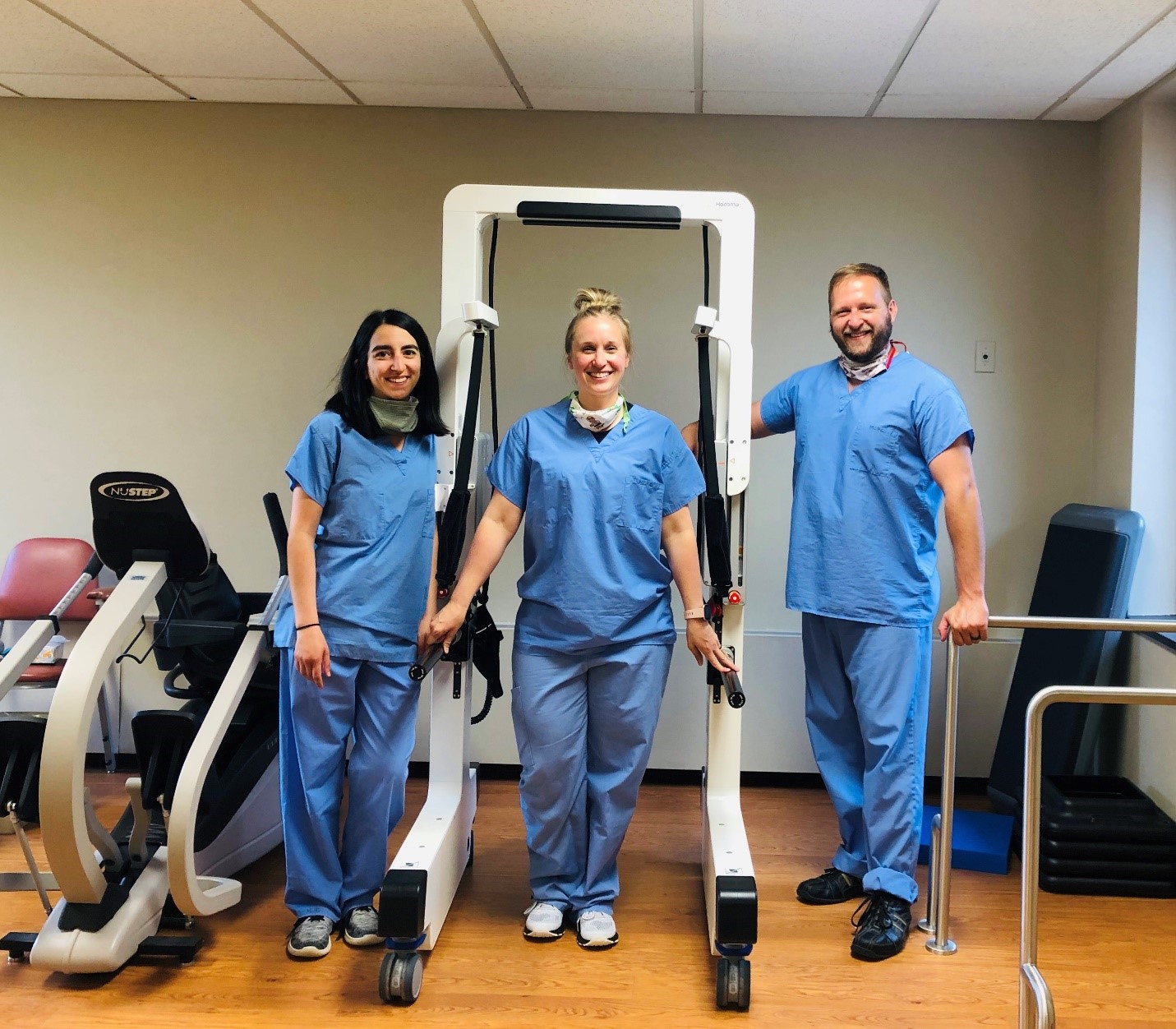October 27, 2020
Clinical Integration of the Hocoma Andago® for Geriatric Patients

Heidi Nielsen, PT, DPT
Physical Therapist
Mountrail County Medical Center – Stanley, ND, USA
We have been using the Andago® since March of 2020 with patients who are unable to independently ambulate. The dynamic body weight support and fall limit features have really allowed us to diversify the treatments that we are able to offer our patients, while keeping them and staff safe. Here we would like to share how we have begun to utilize the Andago® in our geriatric population.
Patient Group
Most patients that we treat are geriatric and have a disability that requires a longer length of rehabilitation than what may be provided in an inpatient rehabilitation setting. The patients we treat with the Andago are patients who are debilitated and require some level of assistance to ambulate.
Our main goal is to always improve patient function, whether it be with transfers, balance, or even ambulation. Subsequently, we also are looking to improve the patient’s quality of life.
Prescription: Inclusion Criteria
We follow the Hocoma User Manual indications and contraindications to prescribe the therapy to our patients. The therapy parameters are set and the decision of including robotics into the therapy plan is made by the primary Physical Therapist.
It is important to note that we even utilize the Andago with patients who have not been ambulatory for a prolonged duration. In fact, the first two patients we had in the device had not walked in over 2-3 years.
Duration and Frequency of Sessions
The Andago is used as a component of the therapy sessions we provide; meaning that it may not be used for the entirety of the session as there are other functional, non-standing or non-ambulatory goals that may be addressed during a treatment session. We utilize the Andago for 20-30 minutes of standing and ambulation, 2-4 times per week.
Patient Evaluation
We administer the Tinetti Gait and Balance Assessment as well as general transfer ability and strength and range of motion assessments at time of admission. Most of our residents are long-term clients who make our facility their home.
Patient Examples
One of our first residents to use the Andago had not walked in several years after suffering a stroke with left-sided hemiplegia. On the first session, she was able to stand with the machine and, after getting used to the suspension and support of the machine, was able to start walking right away. She was smiling for a week after this experience. The majority of staff observing were either shedding tears of happiness or fighting them back! The family of the resident was present via video chatting and was able to share in the extreme enjoyment. After 1 month of use, she no longer needs assist at her left foot to progress it forward and has decreased her body weight support from 100 lbs total to 50-60 lbs total. We have been implementing squats and weight shifting/balance activities into her routine and are seeing improved participation with all transfers as well as improved mood in general. After 5 months of use, we are back to pivot-transferring (instead of needing mechanical standing lift) and she has been able to practice ambulation with a front-wheeled platform walker without the use of the Andago.
Another resident who has Parkinson’s disease and also was not ambulatory for a prolonged period of time, is using the Andago with 50-60 lbs of unilateral body weight support. He, too, has been practicing weight shifting, squats, and most recently has been able to implement portions/activities from LSVT Big. He is unable to fully complete LSVT program at this time, but he has shown improvements with step length and speed of gait with just incorporating the ‘Think Big’ mindset. He has improved his gait speed and cadence.
We have implemented using this machine with other residents as well who have had a recent decline in health status and resultant weakness/difficulty with ambulation and transfers and have seen excellent results with return of function and overall affect. Most residents tell staff and family that they “walked today” and talk about the Andago for many days after use.
Organization: Responsible Therapy Team
At the time we acquired the Andago we had 1 Physical Therapist that was providing therapy for the skilled nursing facility, swing bed unit in our hospital, and outpatient therapy services. Since then we now have three physical therapists.
Reasons to Include the Andago as Part of the Therapy Program
- Incredibly mobile unit that is transportable and does not require dedicated space in a therapy gym
- Decreases the need for assistance of at least two skilled staff to transfer or ambulate patients with moderate to severe impairments
- Secure harness and suspension system that is 100% adjustable to each individual for fall prevention
Billing and Financial Compensation of Andago Therapy
There is no special refunding for our robotic treatment in general. The Andago is a part of the rehabilitation process at our facility, which is covered by the health insurance.
We were able to purchase the Andago through grants and a very generous donation from a family in our community.
About us
The Montrail County Medical Center is a rural facility which includes a critical access hospital (CAH), 11 bed swing bed unit, 36 bed skilled nursing facility (SNF), senior independent living apartments, assisted living facility, health clinic with lab and radiology, and outpatient physical therapy clinic as well as a therapeutic indoor public swimming pool.
We recently had a major change in management in many departments within a very short period of time: CEO, physical therapy department, director of nursing at CAH, and director of nursing at SNF positions to name a few. Physical therapy had decreased from two PT’s and one part-time PTA to just one physical therapist spread between outpatient clinic, swing bed, and skilled nursing facility. Consequently, the residents in the nursing facility were not getting adequate activity and exercise which had previously been provided by 2 PT’s and 1 PTA throughout each week. A fairly significant and fast decline in independence and strength was observed in quite a few of our residents. Most of the residents required at least assist of two staff for transfers and were not safe for ambulation, leading to many sitting in their chairs most of the day. This is the point at which I decided I needed to find an effective, supportive/safe, and simple machine that is low maintenance and requires minimal staff to use to get our residents up out of their chairs and improve their quality of life.
The Andago has been very well-received and has changed this facility’s capabilities thus far and we very much look forward to additional positive reactions in our community and with our residents which will be created by this wonderful piece of equipment.
This clinical experience report is meant to serve as an example of how the Andago is integrated into one particular rehabilitation center. It is not necessarily a standard recommendation from Hocoma.


